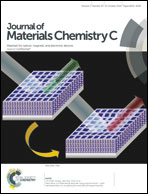Synthesis and properties of low bandgap star molecules TPA-[DTS-PyBTTh3]3 and DMM-TPA[DTS-PyBTTh3]3 for solution-processed bulk heterojunction organic solar cells
Abstract
Two symmetrical planar star shaped organic small molecules TPA[DTS-PyBTTh3]3 (1) and DMM-TPA[DTS-PyBTTh3]3 (2) with TPA and fused TPA core donors, respectively, and three branched DTS-PyBTTh3 units were synthesized and characterized. These small molecules were used as donor materials along with PC71BM as acceptor for solution-processed bulk heterojunction (BHJ) solar cells. The power conversion efficiency (PCE) of the solar cells based on 1 and 2 is about 2.87% and 3.83%, respectively, when the active layers were processed in chlorobenzene (CB) solvent. The higher PCE of the solar cell based on 2 may be attributed to its low bandgap and broad absorption profile as compared to 1. The PCE of the solution-processed BHJ solar cells was improved up to 3.88% and 5.81% for 1 and 2, respectively, when active layers were processed with 0.4% (v/v) 1-chloronaphthalene (CN) as additive in the CB solvent. The enhancement in the PCE was mainly because of the increase in Jsc and FF. The increase in the Jsc and FF may be attributed to the balance charge transport between the electron and hole transport and reduction in the bimolecular recombination, leading to an increase in the PCE.
![Graphical abstract: Synthesis and properties of low bandgap star molecules TPA-[DTS-PyBTTh3]3 and DMM-TPA[DTS-PyBTTh3]3 for solution-processed bulk heterojunction organic solar cells](/en/Image/Get?imageInfo.ImageType=GA&imageInfo.ImageIdentifier.ManuscriptID=C4TC01495B&imageInfo.ImageIdentifier.Year=2014)

 Please wait while we load your content...
Please wait while we load your content...